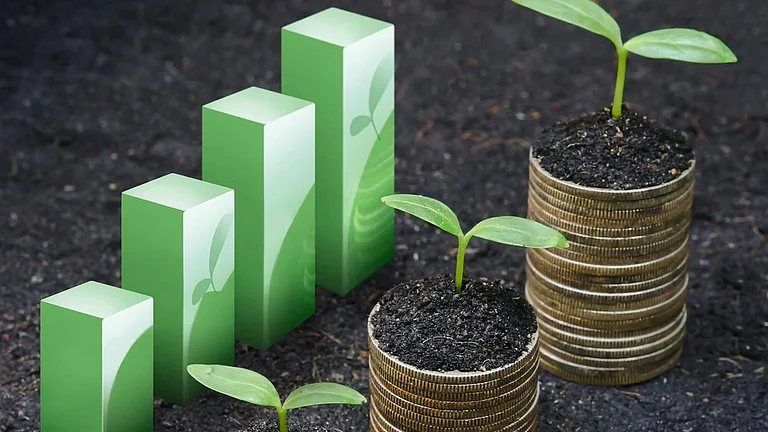In the context of escalating global environmental and social challenges, investors and stakeholders are expecting businesses to adopt responsible practices. Environmental, social and governance (ESG) as a framework for evaluating a company’s sustainability and ethical practices has become the norm. It is becoming increasingly clear to global businesses that attracting international investors and accessing global capital markets is contingent on how they perform across three key areas: environmental impact, social responsibility and corporate governance. The triple bottom line today has become an oft-used phrase in the lexicon of responsible business.
Linking ESG to Growth
India aims to become net zero by 2070 and has been working diligently towards achieving this goal, ranking fourth globally in renewable energy installed capacity. India’s installed non-fossil fuel capacity has increased 396% in the last 8.5 years and is at 220 gigawatts (GW), while solar energy capacity has increased 30 times and is currently at 92.19 GW. The country’s ambitious renewable energy target of reaching 500 GW in non-fossil fuel capacity by 2030 is backed by decisive action.
The Indian government is aware that ESG practices help address not only pressing issues such as climate vulnerability, social inequality and governance gaps but can also give Indian companies a much-needed competitive edge.
Market regulator Securities Exchange Board of India (Sebi) has modified the ESG compliance framework Business Responsibility and Sustainability Report (BRSR), making it more stringent and aligned to global ESG frameworks like the Sustainable Development Goals (SDGs) and UN Principles for Responsible Investment (PRI).
According to a 2024 survey report by the ESG consultancy Uniqus Consultech and IMA India, large Indian companies are making rapid progress in sustainability, with 75% having defined sustainability goals and 84% voluntarily disclosing their targets. Fifty per cent of large companies have successfully embedded ESG into their business strategies. Needless to say, ESG has emerged as a key factor in India’s vision for growth—whether it is to attain a $10trn gross domestic product (GDP) dream or to achieve stringent climate goals.
Leveraging AI across Sectors
These days artificial intelligence (AI) is being discussed extensively in the context of ESG—almost as if it were a panacea. AI has received global attention in the past few years with almost all developed countries articulating their national AI strategies. Today the world believes that AI has the potential to revolutionise ESG practices.
AI is indeed playing a significant role in protecting the planet and ensuring all round prosperity. Bringing in efficiency, reducing waste, promoting innovation in various sectors, reducing emissions, conserving biodiversity and promoting sustainable use of resources are its current forte.
AI adoption in India is quite pervasive. India has been leveraging AI across various sectors to enhance accessibility, innovation and efficiency. Initiatives like Bhashini and Bharatgen demonstrate the government's commitment to integrating AI into national development. AI is also transforming defence, space exploration and transportation in India. The Indian Army has used AI-enabled drones for intelligence and reconnaissance. Disaster management and cybersecurity are being strengthened with real-time analytics. In space exploration, AI played a critical role in Chandrayaan-3, ensuring safe landings. Indian Railways employs AI to optimise its operations.
Finding a Way Ahead
While there is consensus on the value that AI can bring to ESG, there are also concerns about its impact on the environment and society. AI is energy intensive. AI detractors would gladly say that ‘AI is power hungry’. They are not wrong. For example, the data centre industry, which powers AI applications, is estimated to contribute 2–3% to global greenhouse gas emissions. Almost 1.5% of current global electricity use is from data centres. Large language models (LLMs) like GPT-4 and LaMDA are very popular but their potential electricity consumption is projected to reach almost 134 terawatt-hours (TWh) by 2027. This amount of energy is consumed by nations as big as Sweden and Argentina.
Given this scenario, can AI help further ESG goals without compromising environmental sustainability? It is not just this energy dilemma that corporates have to address but other potential risks of using AI—apart from algorithmic bias, AI is known to promote socioeconomic disparities, demonstrate cultural bias and compromise data privacy and security.
Indian companies that have succumbed to the lure of AI are hunting for solutions. And there are a few promising ones. For example, data centres can explore renewable energy sources and smaller AI models with algorithmic efficiencies. AI researchers are pushing the boundaries of performance by doing more with less. They are turning to small AI models or ‘small language models’ in which computational efficiency and cost-effectiveness are redefined. Despite their reduced size, SLMs still pack a punch—processing several billion parameters, allowing them to operate efficiently even on compact devices like smartphones. This can solve AI’s large carbon footprint issue.
ESG is no longer optional. AI has demonstrated its prowess in achieving ESG. Therefore, business leaders should carefully navigate the AI-ESG nexus. Integrating AI into ESG strategies effectively requires a comprehensive and strategic approach that balances technology with human judgment and decision-making.
Indian businesses have to foster a mindset of responsible innovation by leveraging AI. They can then collectively address environmental issues, social dilemmas and governance gaps. They have to explore energy-efficient models and collaborate with technology providers committed to sustainability. AI can become ESG’s hero and a strategic corporate asset—only if business leaders are willing to bite the bullet.
The writer is president of Foundation for Futuristic Cities and former independent director, Engineers India, under the Ministry of Petroleum and Natural Gas





























